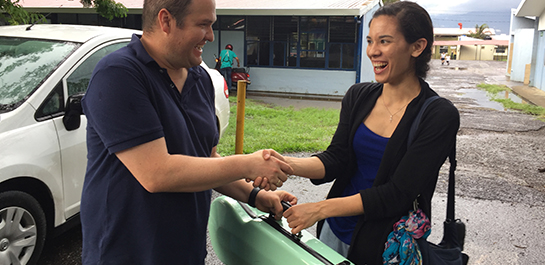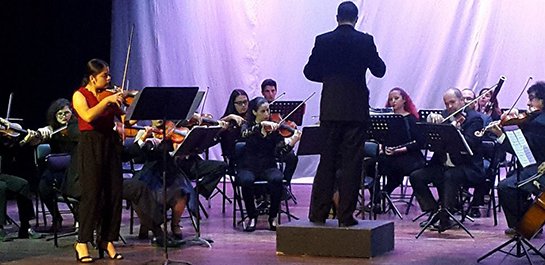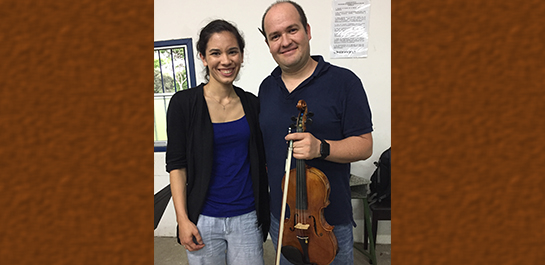WRITTEN BY CLAIRE ALLEN IN DECEMBER 2017
This is the story of a very special violin that began its life in a workshop in Scotland and currently resides in San José, Costa Rica in the hands of a gifted student. Its journey has taken it across the Atlantic Ocean, to our Instruments in the Attic supply room, through the workshop of luthier Jason Day, and briefly through my own hands as a violin teacher traveling to Central America to teach, play, and learn.
We know very little about about the origins of this particular violin. The existence of any violin in itself is a miracle – the creation of a single instrument takes weeks of labor, materials from all over the world, and techniques that took centuries to perfect. No label identifies the maker of our violin, just the words “Glasgow 1908” written on the inside of the instrument in pencil. We know two things: At some point, the instrument was severely damaged, and it was donated to Instruments in the Attic sometime within the last ten years.
Instruments in the Attic began as an outreach initiative for the George Mason University School of Music by J.P. Phaup in 2007 and was expanded by then assistant director of Potomac Arts Academy (former name of Mason Community Arts Academy), John Kilkenny. It has evolved into one of the farthest-reaching and most impactful parts of the Academy under Director Libby Curtis. It was therefore a natural addition to Mason’s new International Teaching Scholars program that brought GMU students and professors with Academy staff, faculty, and board members to San José, Costa Rica, this past spring.
Here’s where I enter (albeit briefly) the story of the Glasgow violin. When I joined the team heading to Costa Rica, it was decided that I would use one of our higher quality Instruments in the Attic violins to perform and teach while in San José. I would then leave the violin at one of the schools we visited for a student to use going forward. So, I paid a visit to Day Violins in Chantilly, Virginia shortly before my departure. Day Violins is owned by Jason and Jenna Day, who have donated countless hours of labor and materials to restore string instruments to playing condition for Instruments in the Attic. Jason let me try out various instruments in the collection before I selected the Glasgow violin to take to Costa Rica. He had completed several heavy repairs on the instrument in order to restore it to playing condition.
Jason writes, “The violin was in terrible disrepair when I got it. The top had several cracks in it and someone had decided to strip all the varnish off of the violin, which was a terrible shame. So, that [the varnish] was redone as well and antiqued to match the age of the violin. Literally, it was brought back from the brink!”
I took the violin home, continued practicing my Spanish, and began getting acquainted with the instrument. A week later, this 110-year-old Scottish violin and I boarded a plane bound for Costa Rica.
I wrote about my experiences over the summer (“Building Musical Relationships in Costa Rica”) with Jason and Jenna fixing instruments at Conservatorio de Castella, an arts magnet school in Heredia, some 30 minutes outside of downtown San José. My time spent there was the most significant experience of my visit to Costa Rica, and it was to this school that the Glasgow violin would be donated. I spent two days there fixing instruments with the Days, and returned for a third to visit a strings class taught by violinist Juan Carlos Martínez.
I had a wonderful time visiting Juan Carlos’s class. I took the Glasgow violin out of the case, wincing a bit at the humidity, and sat in with the first violin section. We played some fun pieces, including arrangements of songs by the Beatles. I laughed to realize that “¡No corre!” (“No running!”) was the correction given most frequently to the violin section. My own students hear me tell them not to rush on a weekly basis. It would seem that certain violinist traits transcend cultural boundaries.
I performed a short section of the Fiocco Allegro for the class, and then fielded questions from them about studying music in the United States, which tested the limits of my Spanish vocabulary! Luckily, Juan Carlos had studied at the Berklee School of Music in Boston and his English was much better than my Spanish, allowing him to translate for me when needed.

When I told Juan Carlos that the violin I had played on was in fact a donation from my organization to Conservatorio de Castella for a student to play, he was shocked and incredibly grateful. I told him that I understood the feeling, because one of my own private students plays on an instrument loaned to him by Instruments in the Attic that has transformed his life. We connected over how challenging it can be to teach an advanced student advanced repertoire when they don’t have access to a high-quality violin. The right instrument really does make all of the difference for these students. We also connected over our shared love of music, teaching, and our desire for our students to have access to every musical opportunity possible.
It’s been months since the Glasgow violin and I spent six short days in Costa Rica, but the story doesn’t end with me handing the violin to Juan Carlos and returning to the States. He and I recently exchanged emails in which he told me of the newest chapter in the life of the violin. He wrote, “El violín que donaron lo está tocando mi alumna Jimena Garita, ella fue escogida para tener el violín durante su último año de Colegio. Algo muy bonito es que este año ella ganó un concurso y el sábado anterior tocó la Romanza #2 de Beethoven con la Orquesta Sinfónica de nuestro Colegio. Ella ha tenido un gran avance con la ayuda del violín.” Translated roughly, this reads, “The violin that was donated is played by my student Jimena Garita. She was chosen to have the violin for her last year at school. Something very beautiful is that this year, she won a competition and last Saturday played the Romance No. 2 by Beethoven with the Symphonic Orchestra of our school. She has had a great advance [in her playing] with the help of the violin.” Juan Carlos was also kind enough to provide a photo of Jimena performing (pictured below).

The existence of a violin is a miracle in itself. The journey of a completed violin can lead to a unique brand of musical diplomacy and create social change in the communities it passes through. And the effect a violin can have in the hands of a musician who loves it is impossible to measure by any standard. It’s my hope that the Glasgow violin continues to transform Jimena’s life, as well as the lives of any Castella students after her who are so fortunate as to play it.
Many thanks to Elizabeth Curtis, Jason Day, Carlos Valverde Infante, and Juan Carlos Martínez for providing information for this post.

